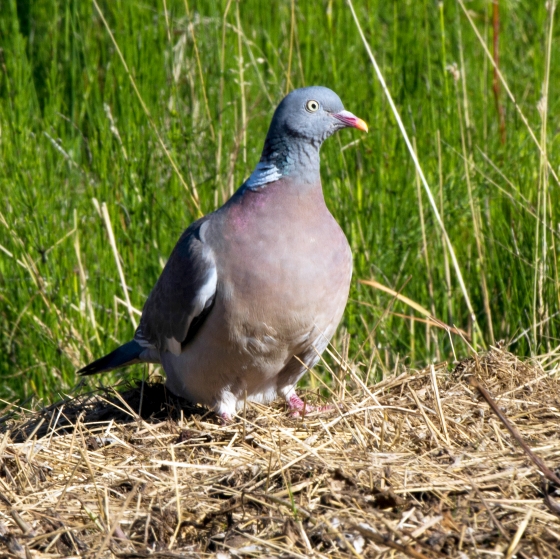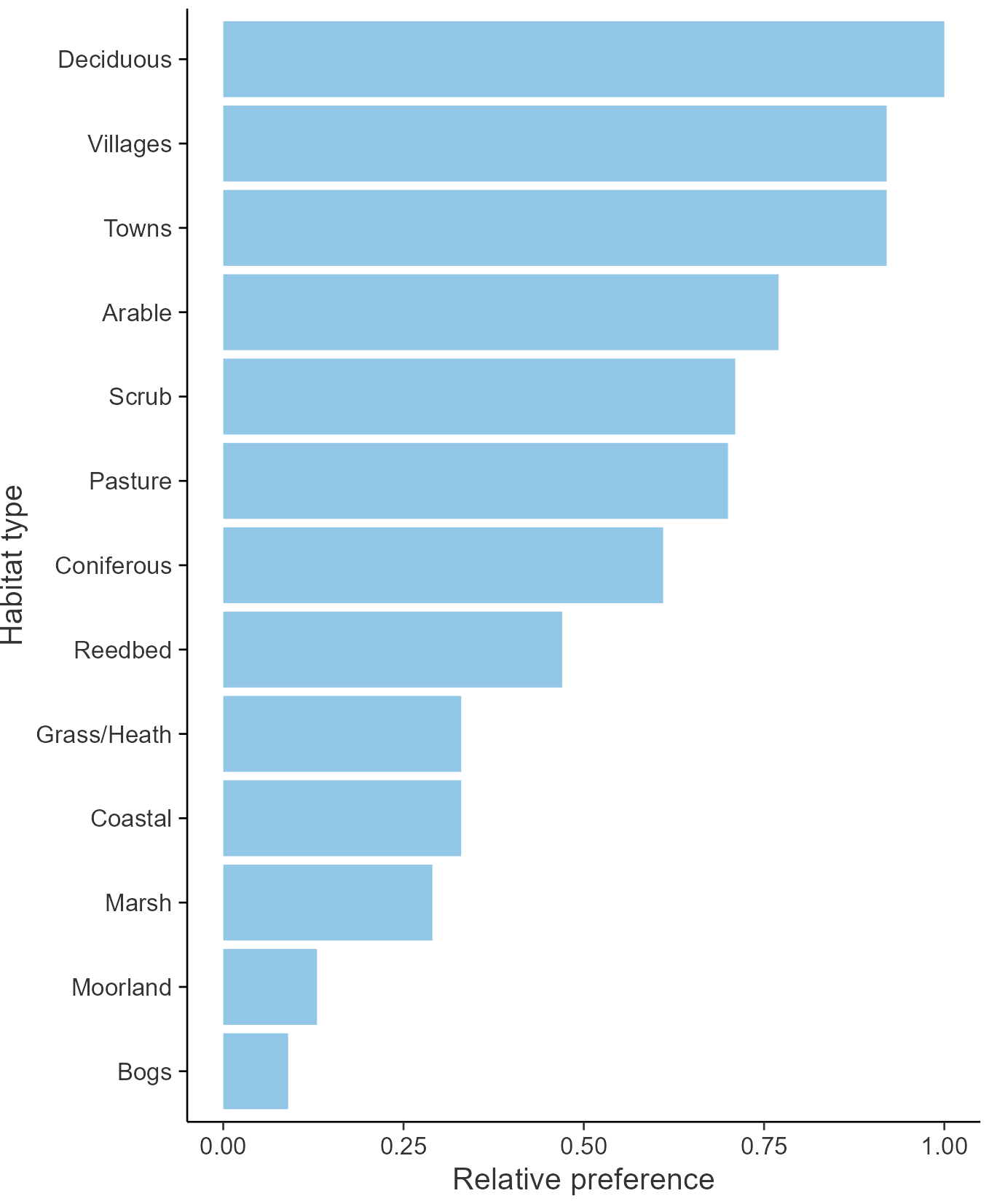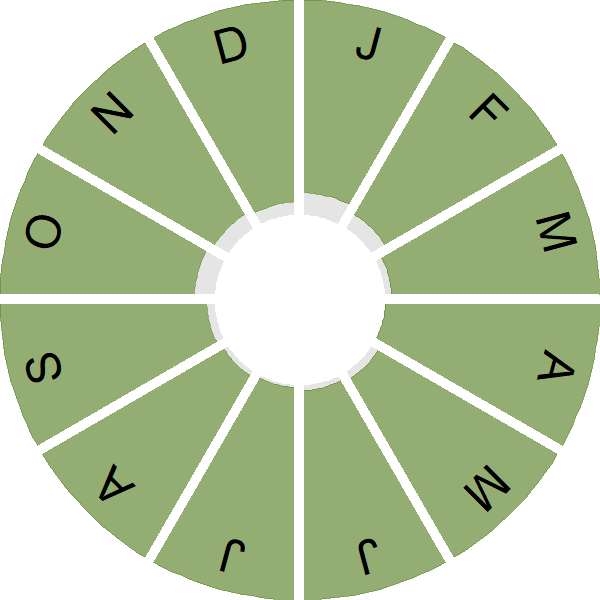Woodpigeon

Introduction
The Woodpigeon is an attractive bird, all pinks and blue-greys, with a bright yellow eye and a red and yellow bill.
This common bird can be seen throughout the UK, across a range of habitats. The breeding population is thought to be around five million pairs, and this is a species that can nest at any time of the year, although its peak breeding season is through the summer months.
From late October through most of November, large flocks, sometimes numbering in the tens of thousands, can be seen on migration, flying high and south on clear, sunny days. Where they are going is open to debate but many thousands arrive in the Iberian Peninsula at this time.
- Our Trends Explorer gives you the latest insight into how this species' population is changing.

Key Stats
Identification
ID Videos
This section features BTO training videos headlining this species, or featuring it as a potential confusion species.
Pigeons
#BirdSongBasics: Collared Dove and Woodpigeon
Songs and Calls
Song:
Status and Trends
Conservation Status
Population Change
The CBC/BBS trend for this species is of a steady, steep increase since at least the mid 1970s. This has only recently started to level off, with BBS showing a very shallow but statistically significant decline in England over the most recent five year period. Since 1995, BBS has recorded significantly upward trends in the UK, and in England and Northern Ireland separately, but stability in Scotland and Wales. The BBS map of change in relative density between 1994-96 and 2007-09 indicates that increase has been very widespread, with decreases only in parts of northeastern Scotland. Breeding success was increasing strongly during the 1970s and 1980s but is currently stable or in shallow decline. There has been an increase across Europe since 1980 (PECBMS: PECBMS 2020a>).
Distribution
Woodpigeons occupy virtually every 10-km square within Britain and Ireland with the exception of the higher mountain zones of Scotland and some northern and western islands offering little woodland cover. The highest densities occur in the arable eastern lowland regions of both Britain and Ireland, with marginally lower abundance in the more heavily wooded regions of southeast England and still lower abundance in pastoral areas.
Occupied 10-km squares in UK
or view it on Bird Atlas Mapstore.
or view it on Bird Atlas Mapstore.
European Distribution Map
Distribution Change
Relatively few gains and losses have occurred in either season and these are mainly along the northwestern periphery of the range.
Change in occupied 10-km squares in the UK
or view it on Bird Atlas Mapstore.
or view it on Bird Atlas Mapstore.
Seasonality
Woodpigeons are very widely recorded, present on over 60% of complete lists in all weeks of the year.
Weekly pattern of occurrence
The graph shows when the species is present in the UK, with taller bars indicating a higher likelihood of encountering the species in appropriate regions and habitats.

Habitats
Breeding season habitats
Relative frequency by habitat
The graph shows the habitats occupied in the breeding season, with the most utilised habitats shown at the top. Bars of similar size indicate the species is equally likely to be recorded in those habitats.

Movement
Britain & Ireland movement
Foreign locations of birds ringed or recovered in Britain & Ireland
Dots show the foreign destinations of birds ringed in Britain & Ireland, and the origins of birds ringed overseas that were subsequently recaptured, resighted or found dead in Britain & Ireland. Dot colours indicate the time of year that the species was present at the location.
- Winter (Nov-Feb)
- Spring (Mar-Apr)
- Summer (May-Jul)
- Autumn (Aug-Oct)

European movements
EuroBirdPortal uses birdwatcher's records, such as those logged in BirdTrack to map the flows of birds as they arrive and depart Europe. See maps for this species here.
The Eurasian-African Migration Atlas shows movements of individual birds ringed or recovered in Europe. See maps for this species here.
Biology
Productivity and Nesting
Nesting timing
Egg measurements
Clutch Size
Survival and Longevity
Survival is shown as the proportion of birds surviving from one year to the next and is derived from bird ringing data. It can also be used to estimate how long birds typically live.
View number ringed each year in the Online Ringing Report.
lifespan
Survival of adults
Survival of juveniles
Biometrics
Wing length and body weights are from live birds (source).
Wing length
Body weight
Ring Size
Classification, names and codes
Classification and Codes
- Order: Columbiformes
- Family: Columbidae
- Scientific name: Columba palumbus
- Authority: Linnaeus, 1758
- BTO 2-letter code: WP
- BTO 5-letter code: WOODP
- Euring code number: 6700
Alternate species names
- Catalan: tudó
- Czech: holub hrivnác
- Danish: Ringdue
- Dutch: Houtduif
- Estonian: kaelustuvi e. meigas
- Finnish: sepelkyyhky
- French: Pigeon ramier
- Gaelic: Calman-coille
- German: Ringeltaube
- Hungarian: örvös galamb
- Icelandic: Hringdúfa
- Irish: Colm Coille
- Italian: Colombaccio
- Latvian: lauku balodis
- Lithuanian: paprastasis keršulis
- Norwegian: Ringdue
- Polish: grzywacz
- Portuguese: pombo-torcaz
- Slovak: holub hrivnák
- Slovenian: grivar
- Spanish: Paloma torcaz
- Swedish: ringduva
- Welsh: Ysguthan
- English folkname(s): Ring Dove
Research
Causes of Change and Solutions
Causes of change
There is some evidence that the increase in this species has been due to the spread of intensive winter cereal and rape cultivation, probably by increasing food availability over winter, reflecting the species' ability to subsist on green vegetation, unlike other granivores.
Further information on causes of change
There are few studies specifically examining demographic and ecological drivers of the long-term increase in this species but the spread of intensive arable cultivation, especially of oilseed rape and winter-sown cereal, which has been shown to reduce overwinter mortality, may explain the rise in numbers (Gibbons et al. 1993, Inglis et al. 1997). Inglis et al. (1997) conducted fieldwork to provide good evidence that, in their study area in Cambridgeshire, the overwintering population size was determined by the area of oilseed rape. Inglis et al. state that, since the introduction of oilseed rape, the number of fledged young produced has a more important effect upon the Woodpigeon population size than does overwinter mortality from starvation, i.e. winter food availability no longer limits the population.
The number of Woodpigeons feeding in gardens has also increased (Glue 1993, 1995, 1997, Plummer et al. 2019), suggesting that this species may benefit from the trend of increasing urban feeding sites, although there is no direct evidence to support this.
The species is adaptable and O'Connor & Shrubb (1986) found that the breeding season had advanced in response to the switch to autumn sowing, and thus earlier ripening, of cereals, with more pairs nesting in May and June and relatively fewer during July-September. Climate change may have also permitted earlier nesting. A trend toward earlier nesting could have led CBC, with its fieldwork finishing in early July, to overestimate the rate of increase (Marchant et al. 1990). Newly available data indicate, however, that the species is now nesting almost three weeks later, on average, than it did in the 1960s.
Information about conservation actions
The Woodpigeon population in the UK increased from the 1970s until around 2010 and has since been stable; hence specific conservation action to benefit this species is not currently required. Conservation actions targeted at declining farmland bird species which increase the availability of seeds in winter may also benefit this species.
Publications (1)
The composition of British bird communities is associated with long-term garden bird feeding
Author: Plummer, K.E., Risely, K., Toms, M.P. & Siriwardena, G.M.
Published: 2019
Newly published research from BTO shows how the popular pastime of feeding the birds is significantly shaping garden bird communities in Britain. The populations of several species of garden birds have grown in number, and the diversity of species visiting feeders has also increased.
21.05.19
Papers


